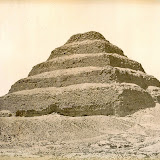Pascal Sebah in Egypt
“The distinction between past, present and the future is only a stubbornly persistent illusion.”
Albert Einstein
Distinguishing the work of Pascal Sebah from his contemporaries, the Abdullah Freres, takes a bit of skill. They were based in Constantinople and worked for the European market so they tended to photograph exactly the same monuments from more or less the same viewpoint. When it came to portraiture they followed European convention, the only difference being that their subjects wore outfits not often seen on the streets of London or Paris. They were the quintessential orientalists but they were not outsiders. Christians raised in Constantinople, they were familiar with the Muslim world, its mores and religious codes. Unlike the Europeans who turned up to open studios, they didn’t have to learn to fit in and knew how to gain access to places off limits to foreigners.
Pascal Sebah, Statue of Ramses 2nd, Egypt 190x250mm, C1860s
Two things mark Pascal Sebah’s work as different from other orientalists. One was that he ranged much further than everyone else, from Constantinople across to Algeria and Morocco. The other was that he appears to have photographed everything he saw. The dogs roaming Constantinople fascinated and offended foreign visitors. Sebah photographed packs of them sprawled on dusty streets. He documented musical instruments and jewelry, people at prayer and nudes reclining on divans, street beggars, middle class merchants and the daughters of nobility. If no other photographer had ever turned up in the Middle East, Sebah’s archive would stand as a sufficiently thorough catalogue.
Pascal Sebah, Ouverture du Pont, Nile, 190x250mm, C1860s
One of the problems with Sebah’s prolificacy is that the idiosyncrasies tend to get obscured by the routine. He understood the two fundamental elements of perspective in 19th century landscape photography; the role of light and shade in the image to create depth and the importance of scale and the great majority of his works conform to the formal aesthetic principles required to meet market expectations. Occasionally he turned to interpretation – there is a famous image of Arabs crossing sand dunes, a camel’s skeleton in the foreground - but mostly he regarded himself as a recorder of fact. Sometimes he turned his attention to details Europeans weren’t interested in. Overwhelmed by spectacle and space, they sought aesthetic beauty in the ruins. The Step Pyramid in his photograph is eroded and crumbling and hardly bears witness to the triumph of Egyptian engineering. Compare it to Legekian’s photograph of the Temple of the Sphinx, which is all symmetry and balance right down to the neatly aligned stonework at the back. Likewise the photograph titled ‘Le Nil (ouverture du pont)’ draws the eye in through the gap to the feluccas on the river but the scene overall is messy and whether intentionally or otherwise he gives a sense of the chaos of activity at the water’s edge. That said, he photographed the pyramid at Cheops, the Sphinx and other famous ruins knowing that so long as he stuck to basic principles he was guaranteed sales.
It is probably the case that he would have found one European obsession with the ancient east baffling. The idea that there was a continuum of empire that linked the Egyptian to the Greek to the Roman, the Byzantine and up to modern times was a point of rivalry between Britain and France. Napoleon had assumed he was a logical heir, the British weren’t so sure of that. European photographers arrived in Egypt at about the mid-point of the great plundering, when temples were sacked and enormous statues shipped up the Nile and sent to museums. One of the motivations for portraying Ancient Egypt’s splendours in pristine beauty was to imply that these were ours, so to speak. As an Ottoman of Arab background (his parents were Syrian) he may have exploited the theory but he can’t have had much sympathy for it. The Ottomans, colonizers of the very lands Europeans believed held their imperial heritage, were excluded from the equation and regarded as tenants rather than landowners.
Legekian, Temple of the Sphinx, Egypt, 200x270mm, C1870s
Pascal Sebah died in 1886 and his son Jean took over the business. Though apparently not christened with his father’s first name he was mindful of his reputation so signed his work J Pascal Sebah. In 1888 he formed a partnership with Polycarpe Joaillier and Sebah & Joaillier became the biggest studio in Constantinople.
J P Sebah, Statues of Ramses, Karnak, Egypt, 200x290, C1880s,
L Fiorillo, Pompey's Column, Alexandria, C1870s
 |
| PASCAL SEBAH AND EGYPT |







No comments:
Post a Comment
Add comments here